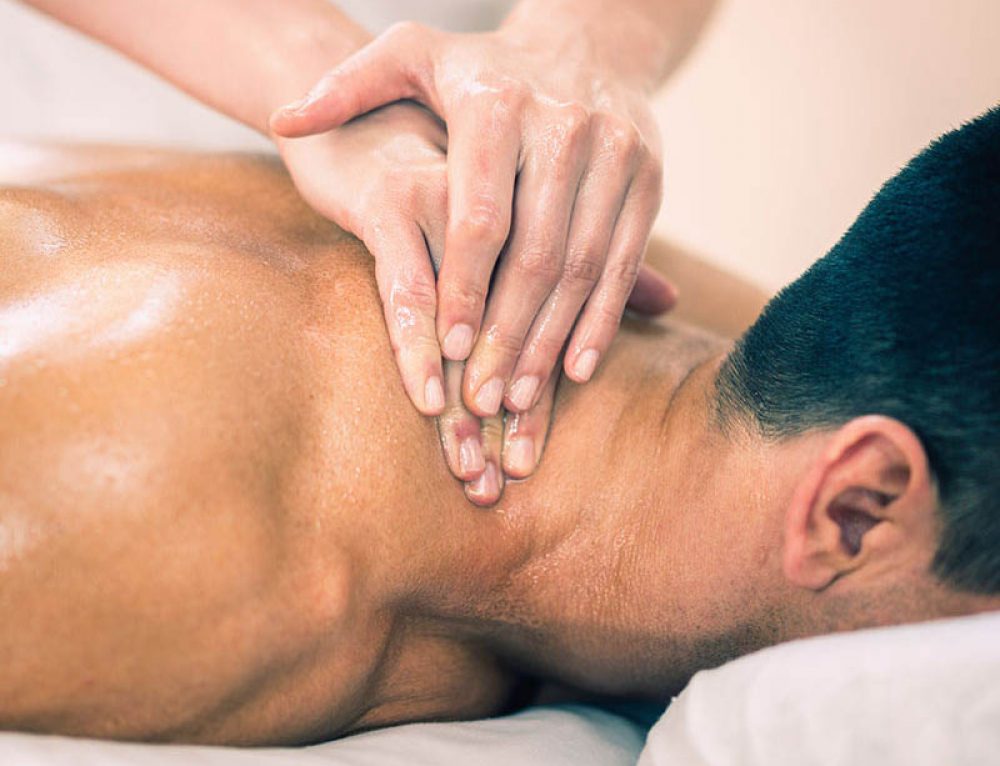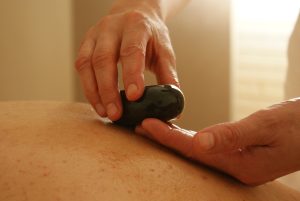Deep tissue massage is an effective and therapeutic type of massage that targets the deep muscles and connective tissues of the body. This unique method helps to relieve tension and stress, improve joint mobility, and contributes to overall healing and recovery after injuries and overexertion. In this technique, the massage therapist utilizes intense pressure and deep movements to achieve maximum penetration into the muscles and alleviate accumulated tension.
Indications for deep tissue massage:


- Chronic muscular pain: Helps to relieve tension and reduce pain in the back, shoulders, etc.
- Limited joint mobility: Improves joint mobility, which is particularly important for people with restricted movement due to conditions such as scoliosis.
- Injuries and rehabilitation: Aids muscle recovery after injuries, promoting tissue healing and improved functionality.
- Migraines and headaches: Reduces tension in the neck area, contributing to a decrease in the intensity of migraines and other headaches.
- Stress and anxiety: Promotes relaxation and reduces stress levels, improving emotional well-being.
Contraindications to deep tissue massage:


Deep tissue massage is an intense and sometimes strong impact on the body, and therefore, some people may have contraindications to this type of massage. Here are some of them:
- Acute injuries: Dislocation, sprains, or torn muscles.
- Inflammation: Arthritis or other inflammatory joint or tissue diseases.
- Bleeding and thrombosis.
- Skin conditions: Eczema, dermatitis, or infectious skin diseases.
- Tumors and neoplasms.
- Late pregnancy.
- Cardiovascular diseases with increased blood pressure.
- Bone conditions: Patients with osteoporosis, osteoarthritis, or other conditions should avoid intense pressure on bones.
Consultation with a professional:


Consultation with a professional massage therapist before the session is crucial to ensure the safety, effectiveness, and comfort of the procedure. Here are some essential points to discuss with the therapist:
- Goals and expectations: It is essential to discuss your goals and expectations from this massage practice, such as the desire to reduce pain in specific body areas, improve joint mobility, or relieve accumulated tension.
- Procedure details: Get familiar with the specifics of the session by inquiring about the techniques the therapist plans to use. It is also beneficial to know what sensations you can expect during the massage and the level of pressure that will be comfortable for you.
Preparation for the massage session:


Proper preparation for a deep tissue massage session is important to achieve optimal results and a comfortable experience. Here are some recommendations to help you prepare:
- Scheduling: Choose a convenient time for the massage session, allowing you to rest afterward and avoid intense physical activities before or immediately after the massage to prevent straining already softened tissues.
- Shower and hygiene: Take a shower before the session to create a more comfortable environment for the procedure.
- Limiting food intake: It is recommended not to overeat before the massage and avoid heavy, fatty, or abundant meals to prevent discomfort during the procedure.
- Rest and relaxation: It’s essential to calm down and relax; deep relaxation of muscles will make it easier for them to respond to massage techniques, and you will benefit more from the procedure.
- Avoiding mobile devices during the session: Put away mobile phones and other devices, allowing yourself to completely disconnect from everyday worries and enjoy the massage process.
By following these recommendations, you will create a more comfortable environment for both the massage therapist and yourself, making the deep tissue massage session more effective and enjoyable!
Questions and Answers:
What is deep tissue massage?
Deep tissue massage is a type of massage therapy that focuses on reaching deeper layers of muscles and connective tissues to relieve tension and promote healing.
What is a massage therapist?
A massage therapist is a trained professional who provides massage services and specializes in various techniques to address different needs.
How can a massage therapist help me?
What are the benefits of deep tissue massage?
Deep tissue massage can relieve chronic muscle tension, improve flexibility, increase blood flow, hydrate the muscles, and release toxins from the body.
How should I prepare for a deep tissue massage?
To prepare for a deep tissue massage, it’s important to wear loose and comfortable clothes and let your massage therapist know about any specific areas of concern or conditions you may have.
Can I get a deep tissue massage if I've never had one before?
Yes, you can get a deep-tissue massage even if it’s your first deep-tissue massage. However, it’s recommended to communicate your preferences and expectations to your massage therapist.
What should I expect during a deep tissue massage session?
During a deep tissue massage session, your massage therapist will apply firm pressure and work on targeted areas to address specific issues. The massage may cause some soreness afterward, but it is a normal response.
How often should I get a deep tissue massage?
The frequency of deep tissue massages depends on your needs and goals. Some people benefit from regular sessions, while others may only require occasional treatments. It’s best to discuss with your massage therapist to determine the right frequency for you.
What are the benefits of deep tissue massage?
Deep tissue massage provides several advantages, including relieving tension, improving joint mobility, increasing blood circulation, relaxing muscles, and promoting overall body wellness.
How often can one have a deep tissue massage?
The frequency of sessions depends on individual needs and goals. However, it is usually recommended to schedule them at specific intervals to allow the body time for recovery.
How long does a deep tissue massage session last?
The duration of a session depends on the chosen time and the specific needs of the client. Typically, the procedure lasts from 30 minutes to 1 hour.
Can deep tissue massage be painful?
During this practice, some areas of the body may cause discomfort or a mild sense of pain, especially when dealing with tense muscles. However, the massage therapist strives not to cause severe pain and adjusts their approach based on your reaction.













![11 Best Alternatives to Bedpage: Your Ultimate Guide [March 2024]](https://massage.dating/wp-content/uploads/2024/03/Best-Alternatives-to-Bedpage-300x200.jpg)
























































































































